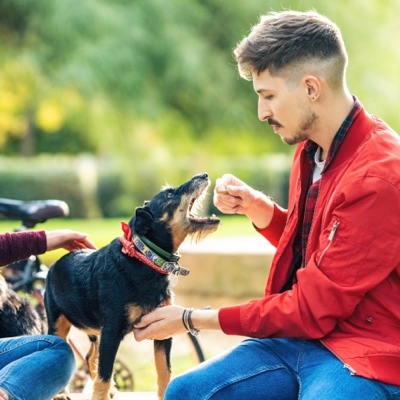Dog Body Language:
Summary:
Dog trainers regularly use language that you may find confusing at first. Don't worry. This article gets you started by providing you with dog training and animal behavior terms and definitions. Once you understand these terms, you'll speak the same language as your dog trainer.


By Sherry Woodard
Just like people, dogs communicate using body language. Your dog is communicating with his entire body, not just his tail or his voice. You'll need to learn to read your particular dog's body language if you want to know how your dog is feeling. To get a sense of what your dog is trying to tell you, spend as much time as you can observing your dog and his body posture.
Because each dog is an individual and will express fear, aggression, stress or joy slightly differently, there are no hard and fast rules for interpreting dog body language. Tail-wagging, for instance, can indicate several emotions. The important thing is to look at the entire body of the dog. With that said, here are some examples of dog body language and what they might mean.
Play bow. The rear end of the dog is up, while the front end is down. The play bow generally means "I want to play".
Tail wagging. Contrary to popular belief, tail wagging (and the position of the tail) can mean many things:
- A low-hung wagging tail could mean "I am scared or unsure."
- A high, stiff wag can mean "I am agitated, unsure or scared, but not submissive. I might bite you or your dog." If the dog's body is stiff, he is staring, and his ears are up, use caution. Keep the dog out of trouble — he may be about to make a bad decision.
- A loose wag — not really high or really low — normally means "I am comfortable and friendly." But, you should keep watching the dog's entire body: Some dogs have a large personal-space requirement. They will tell you if you get too close.
Freeze. A dog freezes if she is scared or guarding, or feels cornered. She may bite, so please slow down.
Rolling over. A dog rolling over onto his back can have multiple meanings. Rolling over generally means "I am not a threat." If the tail is gently wagging and the mouth is slightly open, the dog is probably comfortable and asking for a belly rub. If the tail is tucked and the lips are stiff, however, the dog may be scared. Some dogs will solicit attention by rolling over, but then become fearful or defensive, feeling that this position is not safe. The dog may even panic and start snapping. Again, observe the whole dog, looking for comfortable, loose body language. To be safe, don't hover over a dog or crowd him when he's upside down. Dogs do best when they have the space and ability to change from one position to another quickly and comfortably.
Ears perked up. When a dog's ears are forward, he is alert, interested in something.
Tail between the legs. If the dog's tail is tucked between her legs and her ears are back against her head, she is afraid, uncomfortable with something.
Signs of stress
When a dog is stressed, he often shows Tail tucked, body stiff, looking away: displacement behavior — any of a variety of indicates fear, discomfort. activities that seem inappropriate in the situation they are seen in. These behaviors occur most often during times of emotional conflict. For example, a dog starts self-grooming when he's afraid and faces the decision to fight or run away; grooming is an odd response to a "flight or fight" situation. Displacement behavior can be the dog's attempt to calm himself. Here are some typical displacement behaviors:
- Yawning in new or emotional situations
- Panting when it's not hot
- Lifting a front paw as someone walks toward the dog
- Licking his lips, even though the dog hasn't been Yawning may be displacement eating or drinking behavior.
- Scratching himself when he's not itchy
- Looking away as a person or another animal walks toward the dog
- Shaking off after someone handles the dog or another dog plays too roughly
- Stretching out as though doing a play bow, but not asking for play (sometimes a greeting when a dog is stressed)
- Making a puff (exhale) of breath, sometimes whining at the same time, and looking away or turning away
- Lying down and trying to make whatever is happening . stop by not taking part in it
There is stress along with fear when a dog:
- Starts to drool when she normally doesn't
- Paces or circles
- Tucks his tail and moves away from something
- Starts to whine
- Sweats through her feet
- Puts his hackles up, his tail is low or high, and his body is still
- Starts to growl, and may start to move away, though not all dogs move away from things they fear (Many people punish dogs for growling, which takes away a valuable form of communication) cd
- Starts to curl her lips (Sometimes this is all the warning a dog will give before biting) ould noon several things Tf
- Starts to show his teeth (Again, the warning before biting you don't know the dog, you can be brief, so try to remember every detail of what will learn more shortly. triggered the behavior so you can work on improving or at least managing it)
Diffusing the stress-inducing situation
If you notice that a dog appears stressed, stop whatever you are doing and try to determine what the dog is reacting to. You want to help the dog become more comfortable or manage the behavior in the future so that a bite to a person or animal doesn't happen.
Often, if we slow down whatever situation caused the fear and start exposing the dog in small amounts at a distance, we can help him to completely overcome his fear. We can also help dogs to become more comfortable in general, in order to keep them safe and to keep us safe.
To learn more
If you want to learn more about your dog's body language, Turid Rugaas has a lot of information in her book On Talking Terms with Dogs: Calming Signals. And in her DVD, Calming Signals: What Your Dog Tells You, viewers can see her pointing out various signals dog use to communicate with each other. Other valuable books include these:
- Canine Body Language: A Photographic Guide to Interpreting the Native Language of the Domestic Dog by Brenda Aloff
- Canine Behavior: A Photo Illustrated Handbook by Barbara Handelman
- Dog Language: An Encyclopedia of Canine Behavior by Roger Abrantes
Sherry Woodard is the animal behavior consultant at Best Friends. She develops resources and provides consulting services nationally to help achieve Best Friends' No More Homeless Pets mission.


